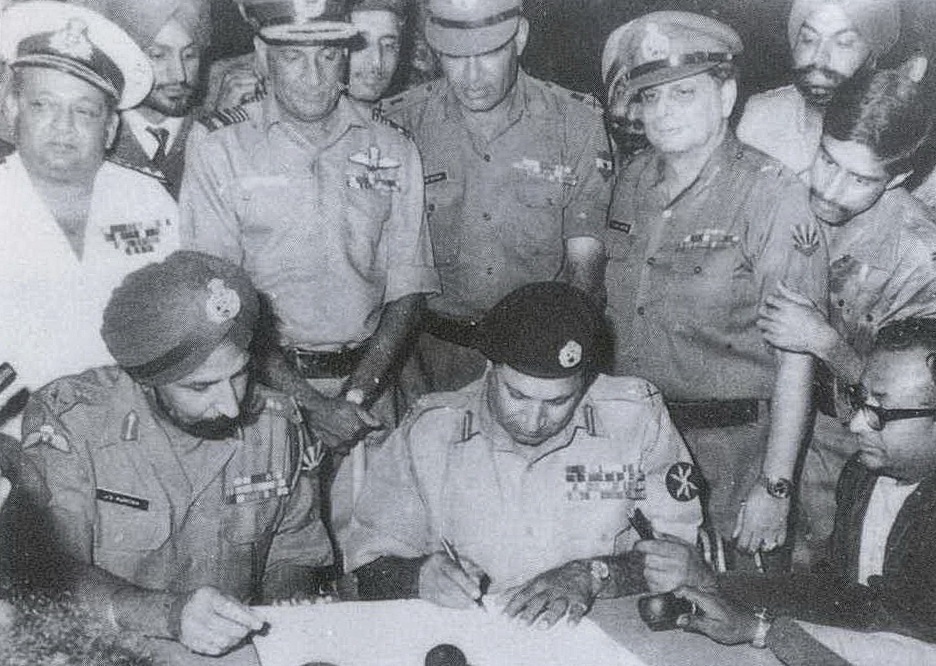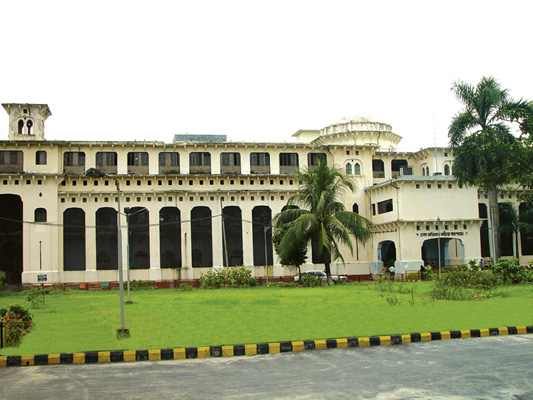|
1971 Dhaka University Massacre
In March 1971, the Pakistan Army Eastern Wing Commander Tikka Khan launched Operation Searchlight on the orders of dictator Yahya Khan to crush the Bengali nationalist movement. As part of the operation, the Pakistani forces performed the 1971 Dhaka University massacre. Black night of 25 March 1971 The Pakistan Army convoy that attacked Dhaka University on 25 March 1971 included the 18th Panjab, 22nd FF, and 32nd Panjab regiments along with several battalions. Armed with heavy weapons such as tanks, automatic rifles, rocket launchers, heavy mortars, and light machine guns, they encircled Dhaka University from the east (unit 41), from the south (unit 88) and from the north (unit 26). Massacre of teachers At the beginning of Operation Searchlight 10 teachers of Dhaka University were killed. Professor Fajllur Rahman and his two relatives were killed at building 23 situated at Nilkhet. Professor Rahman's wife escaped because she was not in the country. The Pakistan Army also atta ... [...More Info...] [...Related Items...] OR: [Wikipedia] [Google] [Baidu] |
Jagannath Hall
Jagannath Hall of Dhaka University is a residence hall for minority students, Hindu, Buddhist, Christian, and others. It is one of the three original residence halls that date from when the University was founded in 1921, and like them is modelled on the colleges of the University of Oxford, a complex of buildings including residences, meeting rooms, dining rooms, a prayer hall, gardens, and sporting facilities. Of the approximately 2000 students of the hall, half live in the residences, and half are non-residential students affiliated with the college. Several professors at the university hold the positions of house tutors and provost at the hall. The hall includes four residential buildings: * Govinda Chandra Dev building * Sontosh Chandra Bhattacharya Bhavan (New Building) * October Memorial Building (October Smiriti Bhaban) * Jyotirmoy Guhathakurta building History Kisorilal Roy Chowdhury, the Zamindar of Baliati in Saturia, Manikganj, who had previously established Jagannat ... [...More Info...] [...Related Items...] OR: [Wikipedia] [Google] [Baidu] |
British Council Bangladesh
British Council Bangladesh is the Bangladeshi branch of the British Council that provides English and British Education and takes part in cultural exchanges. The main office is located in Dhaka and branches are located in Chittagong, Sylhet. Tom Miscioscia is the Director of British Council Bangladesh. History The British Council was founded in 1934 in London. It opened its first branch in Dhaka in 1951 when Bangladesh was a part of Pakistan. On 25 March 1971, at the start of Bangladesh Liberation War, the council office was attacked by Pakistan army, killing 8 East Pakistan Police officers guarding the office. In 2013, the British Council signed a memorandum of understanding with Microsoft Bangladesh to enhance teaching and learning practices. On 16 January 2016, the British Council launched 'Innovate, Incubate and Grow (IIG): A Social Enterprise Support Programme' in collaboration with non-profit organisation Change Maker to promote entrepreneurship. Following the July 2016 ... [...More Info...] [...Related Items...] OR: [Wikipedia] [Google] [Baidu] |
East Pakistan Rifles
East or Orient is one of the four cardinal directions or points of the compass. It is the opposite direction from west and is the direction from which the Sun rises on the Earth. Etymology As in other languages, the word is formed from the fact that east is the direction where the Sun rises: ''east'' comes from Middle English ''est'', from Old English ''ēast'', which itself comes from the Proto-Germanic *''aus-to-'' or *''austra-'' "east, toward the sunrise", from Proto-Indo-European *aus- "to shine," or "dawn", cognate with Old High German ''*ōstar'' "to the east", Latin ''aurora'' 'dawn', and Greek ''ēōs'' 'dawn, east'. Examples of the same formation in other languages include Latin oriens 'east, sunrise' from orior 'to rise, to originate', Greek ανατολή anatolé 'east' from ἀνατέλλω 'to rise' and Hebrew מִזְרָח mizraḥ 'east' from זָרַח zaraḥ 'to rise, to shine'. ''Ēostre'', a Germanic goddess of dawn, might have been a personificatio ... [...More Info...] [...Related Items...] OR: [Wikipedia] [Google] [Baidu] |
Archer Blood
Archer Kent Blood (March 20, 1923 – September 3, 2004) was an American career diplomat and academic. He served as the last American Consul General to Dhaka, Bangladesh (East Pakistan at the time). He is famous for sending the strongly worded "Blood Telegram" protesting against the atrocities committed in the Bangladesh Liberation War. He also served in Greece, Algeria, Germany, Afghanistan and ended his career as charge d'affaires of the U.S. Embassy in New Delhi, India, retiring in 1982. Early life and education Born in Chicago, Archer Blood graduated from high school in Lynchburg, Virginia. He received a bachelor's degree from the University of Virginia in 1943, then served in the U.S. Navy in the North Pacific in World War II. In 1947, he joined the Foreign Service, and received a master's degree in international relations from George Washington University in 1963. Career In 1970, Blood arrived in Dhaka, East Pakistan, as U.S. consul general. When the Bangladesh geno ... [...More Info...] [...Related Items...] OR: [Wikipedia] [Google] [Baidu] |
Bangladesh Chhatra League
The Bangladesh Chhatra League ( bn, বাংলাদেশ ছাত্রলীগ; translation: Bangladesh Students' League; BSL), formerly known as the East Pakistan Student League, often simply called the Chhatra League, is a students' political organisation in Bangladesh, founded by Sheikh Mujibur Rahman on 4 January 1948. BSL is the student wing of the Bangladesh Awami League. During the Bangladesh Liberation War, the Bangladesh Chhatra League was a key player, but in 1972, it broke up into two factions based on their allegiance to Shekh Mujibur Rahman. The group was a pioneer in the 1952 Language Movement, the 1954 general election victory of the United Front (East Pakistan), the anti-Aiyub movement in 1958, the education movement in 1962, the Six-Point movement in 1966, the mass uprising in 1968, and the 1970 general elections. BSL has been repeatedly accused of using torture, extortion, violence, forced prostitution, and killings to instill fear. At least 33 pe ... [...More Info...] [...Related Items...] OR: [Wikipedia] [Google] [Baidu] |
1971 In Bangladesh
The year 1971 was the year when Bangladesh achieved independence and emerged as a sovereign country. Incumbents * President: Sheikh Mujibur Rahman (starting 17 April) * Prime Minister: Tajuddin Ahmad (starting 17 April) Events March * 2 March – First hoisting of the National flag of Bangladesh (initial version) at the Dhaka University by Vice President of Dhaka University Students' Union (DUCSU) leader A. S. M. Abdur Rab. * 7 March – Sheikh Mujibur Rahman makes his historic freedom speech. * 25 March – Pakistan Army launches Operation Searchlight at midnight on the 25th, marking the start of the 1971 Bangladesh atrocities. Sheikh Mujib is arrested. (to 26 March) * 26 March – Sheikh Mujib declares the independence of Bangladesh before his arrest by Pakistani Army. * 27 March – Major Ziaur Rahman broadcasts the declaration of independence on behalf of Bangabandhu Sheikh Mujibur Rahman over the radio. * 31 March – Kushtia resistance begins. April * 2 April – Jinj ... [...More Info...] [...Related Items...] OR: [Wikipedia] [Google] [Baidu] |
Anudoipayon Bhattacharja
Anudvaipayan Bhattacharya ( bn, অনুদ্বৈপায়ন ভট্টাচার্য; 31 January 1941 – 25 March 1971) was a lecturer of the Department of Applied Physics at the University of Dhaka who was killed by the Pakistan Army on 25 March 1971. Early life Bhattacharya was born in a Bengali Hindu Brahmin family on 31 January 1941 in the village of Jantari in erstwhile greater Sylhet district of Assam in British India. His birthplace is now under Nabiganj Upazila in Habiganj District of Sylhet Division in Bangladesh. His father Digendra Chandra Bhattacharya was a school teacher. After the Partition of India and inclusion of Sylhet in East Pakistan, the Bhattacharya family did not migrate to India. As a child Bhattacharya attended the J.K. High School in Nabiganj. In 1961, he passed the Matriculation examination. In 1963, he passed I.Sc. from Sylhet MC College. He complete B.Sc. in physics in 1966 and Masters in applied physics in 1967 from Dhaka Univer ... [...More Info...] [...Related Items...] OR: [Wikipedia] [Google] [Baidu] |
Dhaka Medical College
Dhaka Medical College and Hospital (abbreviated DMCH) is a public medical college and hospital located in Dhaka, the capital city of Bangladesh. It houses medical school as well as a tertiary care hospital on one campus. The country's first ever autologous bone marrow transplant took place in its bone marrow transplant unit. History Site during pre-college years The college's original building was built before the Partition of Bengal of 1905. As of 1904, the building was being used as the secretariat (headquarters) of the newly formed provinces of East Bengal and Assam. In 1921, it was turned over to the University of Dhaka, which was founded that year. A part of the huge building was used as the university's medical center, another part as the students' dormitory, and the rest as the office of the administrative wing of the Arts faculty. In 1939, the Dhaka University council requested the British Government to establish a separate medical college in Dhaka. The proposal w ... [...More Info...] [...Related Items...] OR: [Wikipedia] [Google] [Baidu] |
Dhaka Medical College Hospital
Dhaka Medical College and Hospital (abbreviated DMCH) is a public medical college and hospital located in Dhaka, the capital city of Bangladesh. It houses medical school as well as a tertiary care hospital on one campus. The country's first ever autologous bone marrow transplant took place in its bone marrow transplant unit. History Site during pre-college years The college's original building was built before the Partition of Bengal of 1905. As of 1904, the building was being used as the secretariat (headquarters) of the newly formed provinces of East Bengal and Assam. In 1921, it was turned over to the University of Dhaka, which was founded that year. A part of the huge building was used as the university's medical center, another part as the students' dormitory, and the rest as the office of the administrative wing of the Arts faculty. In 1939, the Dhaka University council requested the British Government to establish a separate medical college in Dhaka. The proposal wa ... [...More Info...] [...Related Items...] OR: [Wikipedia] [Google] [Baidu] |
Asiatic Society Of Bangladesh
The Asiatic Society of Bangladesh is a non political and non profit research organisation registered under both Society Act of 1864 and NGO Bureau, Government of Bangladesh. The Asiatic Society of Bangladesh was established as the Asiatic Society of East Pakistan in Dhaka in 1952 by a number of Muslim leaders, and renamed in 1972. Ahmed Hasan Dani, a noted Muslim historian and archaeologist of Pakistan played an important role in founding this society. He was assisted by Muhammad Shahidullah, a Bengali linguist. The society is housed in Nimtali, walking distance from the Curzon Hall of Dhaka University, locality of Old Dhaka. Publications The society's publications include: * ''Banglapedia, the National Encyclopedia of Bangladesh'' (edition 2, 2012) * '' Encyclopedia of Flora and Fauna of Bangladesh'' (2010, 28 volumes) * ''Cultural Survey of Bangladesh, a documentation of the country's cultural history, tradition and heritage'' (2008, 12 volumes) * ''Children’s Banglapedia'', ... [...More Info...] [...Related Items...] OR: [Wikipedia] [Google] [Baidu] |



